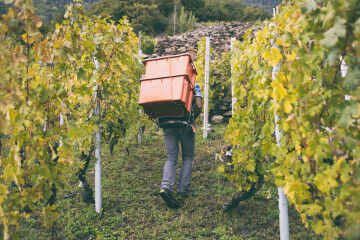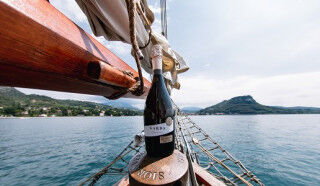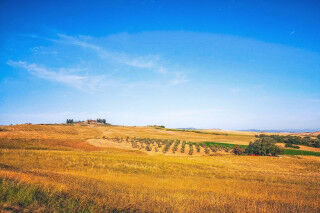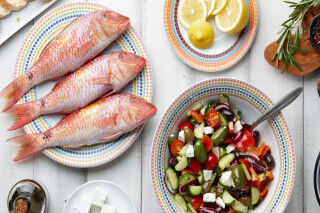NEBBIOLO GRAPES GO MOUNTAIN CLIMBING, CREATING THE HEART OF THE VALTELLINA WINES
Vineyards in Valtellina have always maintained a connection to the history of the local residents. These residents have historically been dedicated to the creation of dry stone walls that today we see dotting the Rhaetian edges of the Alps. These stone walls are created with the intent of supporting the terraced vineyards.
This vineyard-bound countryside, together with its southern exposure, stretches for 60km (approximately 37 miles), and is located at an altitude of between 300-800 meters (or 1300-2500 feet up).
This landscape is just where the great wines of the Alpine Nebbiolo grapes are from. We find the Valtellina Rossi DOC wines, and the Valtellina Superiore DOCG wines in their five appellations - Maroggia, Sassella, Grumello, Inferno and Valgella. Last but not least, the area is also home to the fabled Sforzato di Valtellina DOCG.
The area has over 2,000 years of wine-making history here in the northernmost part of Lombardy. In case you’ve heard of the Nebbiolo Alpine grape referred to as a different name, both options are correct - the grape is also known as the Chiavennasca grape, taking its name from the nearby neighboring area of Chiavenna).
The Valtellina valley follows an east-to-west geographic position, as it follows the flow of the Adda River. The riverbed itself is a foundation of granite that has been traversed for millennia by the glacial waters of the Adda river.
Now that you have the fundamentals of the Valtellina region down, take a look at the foods that make it so special. Don’t miss Valtellina: Northern Italian Nature on Your Table today.
VALTELLINA’S WINE CLIFFS AS SEEN BY ITALIAN DOCUMENTARY DIRECTOR, ERMANNO OLMI
The Valtellina valley provides one of Italy’s most spectacular viticultural landscapes, and is just 100km away from the capital of Lombardy, Milan. Valtellina is also borderline adjacent with Switzerland, whose mountain peaks, like Mount Disgrazia (3,678) cast long shadows onto the Italian vineyards below.
Valtellina’s prime vineyard ripening areas as those vineyards with southern exposure. This exposure however necessitates placement on some of the mountain ranges’ steepest slopes. Consequently, mechanical harvesting procedures are virtually impossible to execute. Manual harvesting then becomes the only option, and necessitates around 1,400 hours per hectare of manual labor - very intense human intervention needed. Every great once in a while, a small cableway crops up in the vineyards that can help speed up the harvesting work, but these are far and few between.
The heroic vintners crafting artisanal wines work on soils that are alluvial, gravelly and well-drained, as well as being rich in silica. A most appealing feature are the large stones scattered at the borders and edges of the vineyards - they serve an unusual purpose. These large rocks collect heat during the day, and release this heat into the soil in the chillier evenings. This naturally-occurring temperature control helps prevent springtime frosts, and helps to maintain stable temperatures during the daytime, when local weather conditions are more variable.
Therefore, the area is cool, yet sunny. Combined with the local geological characteristics, we find an area that is remarkably ideal for the production of quality viticulture, even though the physical considerations of the area make viticulture a challenge. The area’s fresh Alpine breezes, and the warmer currents blowing off of nearby Lake Como create an ideal ambiance to combat local fungal diseases without involving chemical treatments or uses.
Not into wine just now, but still thinking about a drink to enjoy at the end of the day? Italy’s got its finger on the Cocktail pulse sweeping the nation - check it out to learn more about what you can enjoy right at home: Home Bartending - Dry January is Over!
HARD WORK INSPIRES WINEMAKERS IN TODAY’S VALTELLINA AREA
From both a geographic and economic standpoint, Valtellina has much more in common with neighboring Switzerland, a country with whom the valley shares a long-standing connection, than with Italy itself. From 1512 to 1815, the area was underneath protection and tutelage of several Swiss Cantons. In 1815, the Valtellina valley was annexed to Austrian-ruled northern Italy, and it wasn’t until 1859 that the area officially became part of the Kingdom of Italy.
The Valtellina valley was also an important trade route connecting the Po valley to Germany to the north, another major destination for the wines of the Valtellina valley. Today, the viticultural amphitheater hosting the Nebbiolo mountain features 2,500 km of dry-stone walls. This region has been recognized as an Unesco World Heritage site, and the construction of these dry-stone walls represented the only way to make use of the land and soil therein.
The Adda river only provided marshy lands downstream, breathing life into pastures utilized today for other agricultural realities.
Great Italian documentary director, Ermanno Olmi, produced a documentary about the region and its wines, Le Rupi del Vino. When speaking of the Valtellina wines, Olmi noted: "Good, fertile soil and stones: everything was carried on the shoulders, in baskets, by women and men. That's where this heroic culture was born, necessity demanded it.”
The devotion and dedication necessary to make sure this wine region continues to provide the world with its wines is the very same thing that has caused generations of local residents to leave the area in search of an easier livelihood. Today’s hectares planted with vineyards is approximately 850 hectares, with single plots being essentially non-existent. Compare this with the 5,000 hectares in the early ‘900s, and the 3,000 hectares in the 70’s.
Modern-day factory jobs in the valley below proved to be a siren song for many, and the abandonment of these small plots of land began. This had the positive effect of giving more space to apple orchards, and dense woods. However, in more recent times, new generations of local residents are feeling the inspiration to devote themselves to regenerating these wine-making traditions. Some heroic viticulturists began a new chapter of development, where wine estates stopped the focus on the actual cultivation of grapes and focusing more on the bottling of wines.
Paradoxically, the ties that bond with Switzerland also produced a tripping point for some wine estates. Thanks to a commercial agreement between Italy and Switzerland, local importers were obligated to purchase an agreed-upon quantity yearly of Valtellina wines. When this agreement expired in the 1980s, the Valtellina wine industry suffered a major halt. So, once again, the vineyards made more room for apple and fruit orchards.
It’s hard to fathom the immense challenge vintners faced every harvest time. Try and imagine the effort needed to transport countless kilos of grapes down steep mountain paths, in small baskets that could be slung across harvesters’ backs. Called portini, these straw baskets have since been replaced with sturdier plastic baskets or containers. A few select producers have introduced pulled systems to transport the grapes down the mountainsides, but they truly are the exception to the rule.
Looking for more info on Italian food specialties? How about another exciting and lesser-known regio, the Oltrepo Pavese area? Check it out: Oltrepò Pavese’s Wines and Food: an Inseparable Powerhouse.
WHAT’S THE PAYOFF IN WINE TERMS FOLLOWING SO MUCH EFFORT?
Let’s remember the hot, dry summers with their long, sun-filled days that help the grapes maximize their sugar levels. Not only are sugars regulated this way thanks to the local climate, acidity and phenolic ripeness levels are also maintained and stabilized this way. The Rhaetian Alps, located on the valley’s northern side, block the cold northern winds that otherwise would bluster abbout the area. The Orobian Alps, located in the valley’s southern facet, instead, block the winds from the south. The valley overall is warmed as well by the Breva, a warm air originating in the Lake Como area. Also breezing about is the Foehn, a dry Alpine wind sometimes hailing down from the northeast. All the winds, of course, help reduce humidity levels in the Valtellina area.
In order to thoroughly understand the unique features of the Valtellina red wines, a better understanding of the microclimate can be helpful. The Valtellina red wines, certainly the wines originating in the mountain areas, typically feature a vivid, brilliant color, and are fairly light in hue. The colors themselves generally take on orange tints and notes, which you can recognize when peering through your wine glass. The wines themselves are nearly transparent, with images viewable through your glass. Never dark or dense, the wines are typically semi-transparent.
The Valtellina DOC reds include a crimson color, with a cherry and rose bouquet on the nose. A light, spicy taste with a mineral-based hint recalls the native rocks of the Valtellina Alps. Tannins are present, but never intrusive, and gives the wines a backbone to savor. When tasting Valtellina Superiore DOCG, a palpable increase in intensity and complexity is noticeable on the palate. This is also thanks to the wines’ aging process of at least 24 months, 12 months of which are executed in wood.
Moving forward, in this appellation we also come across the five geographical mentions of Maroggia, Sassella, Grumello, Inferno and Valgella. These are the five Crus of Valtellina, although the most renowned wine of the region is undoubtably the Sforzato di Valtellina, also known colloquially as Sfursat.
This wine was the first wine using dried grapes to obtain the DOCG appellation, ahead of the Amarone curve by at least 7 years. Drying grapes is in actuality an ancient practice used throughout the wine-making regions. In the Northern parts of the country, the wines using this process were historically referred to as “straw wines,” in reference to the practice of drying out the grapes on beds of straw.
Sfursats are dry, powerful wines produced from a pin-pointed selection of the finest local Nebbiolo grapes. These select grapes are harvested one week before the remainder of the main harvest. Following their collection, the Nebbiolo grapes are put on wooden racks in a drying room called the fruttaio. This room today has a temperature control managed by a dehumidifier, or are simply left open to capture the natural temperate control actions of passing breezes.
Drying periods typically range from 30-100 days, during which time the grapes will lose between 20-40% of their volume. This naturally helps the grapes concentrate their juice and sugar levels.
Compared to other regional Italian wines, the Sforzati wines of Valtellina have a leg up on their similar bottles, with a greater clarity and brighter elegance than their sister labels. The Sforzati wines also enjoy a reliably supportive acidity, that comes directly from the surrounding mountain scenery. This glorious landscape undoubtably infers on all the Nebbiolo Alpine wines a level of enjoyability that carries throughout time, glass after glass.
Don't forget to register for Mamablip's weekly newsletter for updates on all the exciting newest Mamablip Blog articles, recipes and other wine news from Italy.












